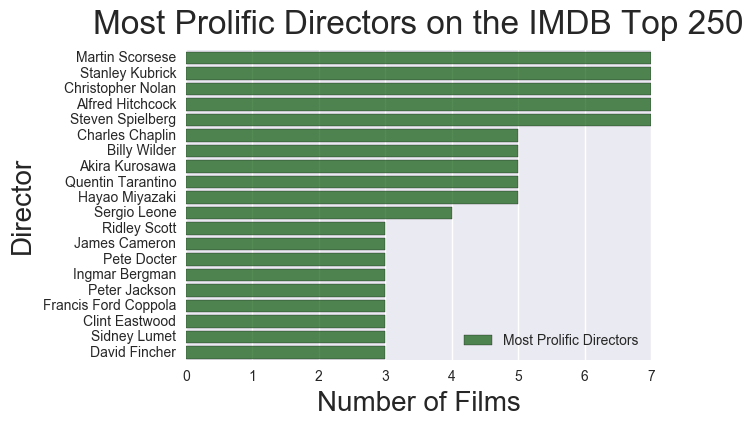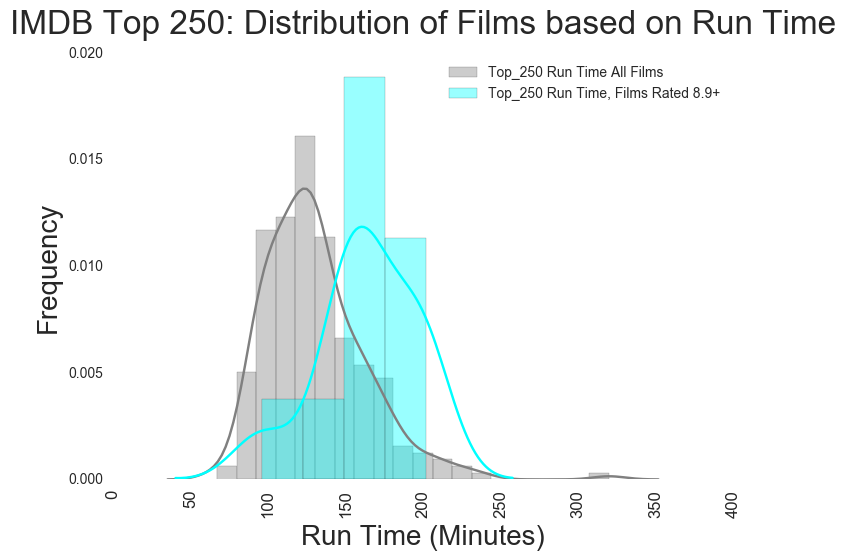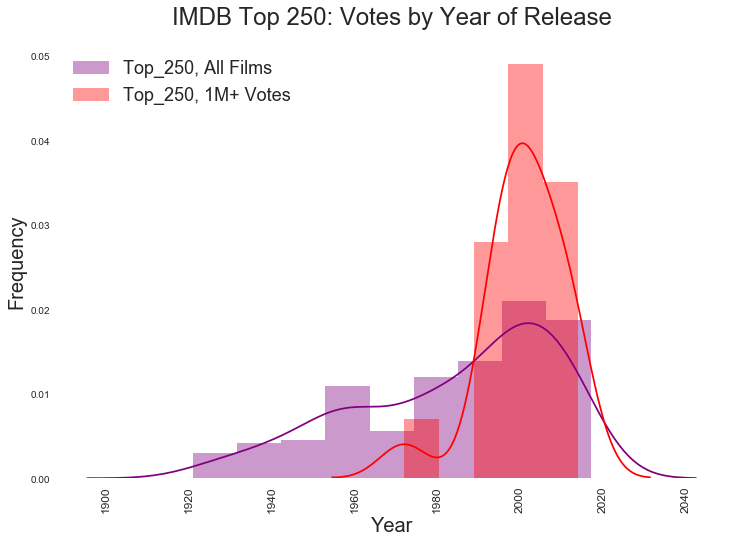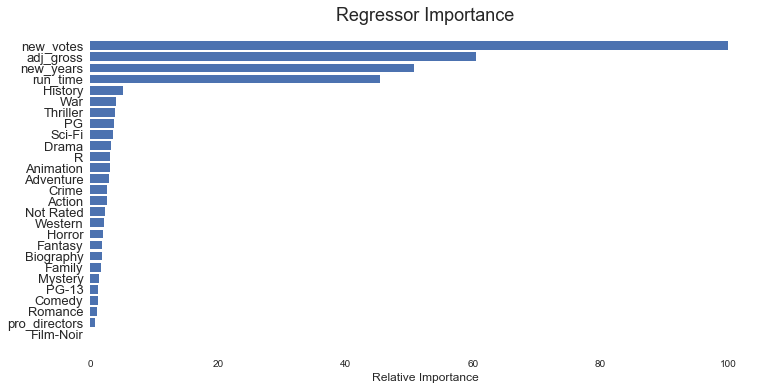Predicting Movie IMDB Ratings
Can we predict the popularity of a movie? When it comes to the IMDB Top 250 list, patterns emerge, but predicting an actual IMDB rating is difficult, at least using classification techniques. A regression model is much better model for predicting these ratings.
BACKGROUND
The popular movie site IMDB provides basic information about movies, including descriptions, studio information, revenues, genres, directors, actors, MPAA ratings and more.
IMDB publishes user ratings for each film on its site. The IMDB ratings are ranked on a 0-10 scale, 10 is excellent, one is poor. The IMDB ratings can change over time as people continue to vote, and/or remove their votes.
IMDB also maintains a list of what it considers the Top 250 movies. IMDB places films on this list pursuant to a formula. This formula produces a weighted average for each film based on a film’s visitor votes and ratings.
PATTERNS
There are patterns among the films on the IMDB Top 250, especially with respect to directors, length of a film and gross revenue.
DIRECTORS
Some directors are better represented than others on the Top 250 list. As one would expect, the most represented directors are among the greatest, and include Martin Scorsese, Stanley Kubrick, and Alfred Hitchcock.

Where’s John Ford?
Oddly, John Ford has only one film on the Top 250: “The Grapes of Wrath”. Among film historians, Ford is best known for “Stagecoach”, “The Searchers” and his so-called cavalry trilogy. What makes Ford’s single entry so peculiar, is that he is perhaps film history’s single most influential director.

In “Stagecoach”, Ford gave birth to the classic Hollywood film narrative. Ford also influenced many of the directors on the Top 250, including Scorsese and Spielberg, both of whom have seven films on Top 250. Akira Kurosawa named Ford as his greatest influence (five films on the Top 250), and Kurosawa in turn provided the cinematic inspiration for the Star Wars series (There are four Star Wars films on the Top 250).
Therefore, Ford’s absence tells us a great deal about the Top 250. While “The Searchers” is a widely heralded film, it is not a favorite among IMDB visitors, who rate it 8.0. The movie has only 67,000 votes. While this may seem high, there are only 30 films on the Top 250 with fewer than 68,000 votes. Of those 30 films, the mean is 8.3; not a single one rates 8.0.

“The Searchers” has Martin Scorsese’s seal of approval, but not enough love in the form of IMDB visitor votes to make the Top 250.
LENGTH
Highly rated films on the IMDB Top 250 tend to be longer, and the highest rated films (9.0+) are all crime dramas.The highest IMBD rated films also tend to be ‘R’ and ‘PG-13’ rated.

GROSS REVENUES
Analyzing IMDB revenues is difficult because the Top 250 spans 95 years, making inflation a legitimate concern. Furthermore, some films drew revenues in francs, rupees, lira, and/or dollars. When we adjust for currency values and inflation, remarkable patterns emerge in the data.

While “R” rated films account for 41 percent of all films on the Top 250, the adjusted mean gross revenue for “R” films is half that of “PG” rated films, and a third of “G” rated films.
The raw earning power of a “PG” film is best exemplified in the above graph. Look at the period between 1975 through 1985. It’s dominated by high grossing PG films. I call this the “Lucas-Spielberg Superhighway” as this swathe of purple bubbles contains the first “Star Wars” trilogy, “Raiders of the Lost Ark” and “Jaws”.
We also see the enduring earning power of “G” rated films in the above visual. “Gone with the Wind” is one of the highest earners on the list, notwithstanding its 1939 year of production.
[In full disclosure, it was necessary to update the ratings for many of the films using IMDB’s suggested ratings, TV ratings, and/or overseas ratings]
VISITOR VOTES
IMDB allows visitors to vote for films. These votes not only influence the rating, but also influence whether a film makes the Top 250.
Newer films are more likely to have over one million votes, and those films rated over 8.9 tend gross more than than the average Top 250 film.

MODELING
Notwithstanding the abundance of patterns in the Top 250 list, it’s difficult to predict IMDB ratings using classification algorithms. Regression techniques work much better.
REGRESSION
A regression model using gradient boosting produced a model with an mean squared error of .03, and an R-Squared of .54.
Decent numbers. When we plot our predictions against actual IMDB user votes, we see that the model predicts most films between 8.0 and 8.5 with minimal error. Even better, close to one quarter of our predicted ratings fall perfectly on the gradient boost regression line.

As demonstrated by the plot below, the best features for a gradient boosting regression model are: 1. Visitor votes (“new_votes”); Adjusted gross income (“adj_gross”); and Year of release (‘new_years’).

The strength of these features are not surprising. Visitor votes are what determines the ratings, and the adjusted gross is stronger in the 1970s & 1980s. The length of a film is at first surprising, but remember that length is longer for highly rated films.
CLASSIFICATION
While a gradient boost regression model shows promise with respect to IMDB ratings, classification models perform poorly when trying to predict ratings with a high degree of accuracy.
A gradient boost classification model with K-Best feature selection can produce a model with 25 percent accuracy. A random forest model produced a model with 27 percent accuracy. Neither are great. Decision trees and random forest models do not perform much better.
K-Best feature selection algorithms tell us that the best variables are length, visitor votes, gross revenue, two MPAA-ratings and select genres (sci-Fi, Fantasy, Western). IMDB on the other hand, places movies on the IMDB list using several factors. Genre is not one of them.
In summary, there are patterns to the IMDB Top 250. We can predict the ratings of films on the Top 250 list, but we cannot do it well with classification models.